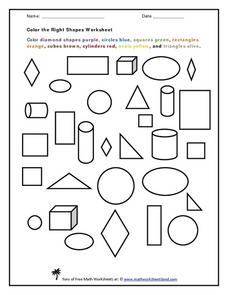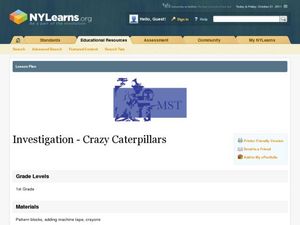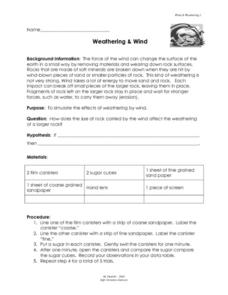Curated OER
One and Tens Place Value - Step-by-Step Lesson
Give your pupils a grasp of place value in a two-digit number. They see a drawing of counting cubes in a stick of ten, then examine a set of four. Mathematicians determine how many blocks there are by grouping the tens. Ideally, you will...
Curated OER
Color the Right Shapes
I remember doing this activity when I was little. Learners color each shape the color indicated at the top of the page. Squares are blue, cubes are red, circles are green and so on. There are 30 shapes to identify and color.
Curated OER
The Hundreds Place
Young mathematicians examine images of counting cubes to determine the value of each set. The arrangement values include hundreds, tens, and ones. Encourage scholars to utilize place value knowledge instead of addition and counting with...
Curated OER
Sorting 3-Dimensional Shapes
The sorting is simple here: Does this three-dimensional figure have a curved surface or not? Scholars review an example before trying this on their own with nine figures including a sphere, cylinder, prism, cube,...
Curated OER
Sorting 3-Dimensional Shapes
Does it have corners? Scholars sort three-dimensional figures into one of two categories based on whether or not they have corners. They look at six shapes: sphere, cylinder, cone, cube, prism, and pyramid. For each,...
Curated OER
Roll A Sentence
For this modifiers worksheet, learners play a game where they roll cubes and write sentences that include nouns, verbs, adjectives, and adverbs.
Curated OER
Investigation: Crazy Caterpillars
First graders explore biology patterns by creating a model insect. In this patterns lesson, 1st graders utilize snap cubes and pattern blocks to recreate their own version of a centipede or caterpillar. Students create their caterpillars...
Curated OER
Sources of Heat
Fourth graders conduct an experiment related to heat sources, and participate in a heat source hunt. They identify sources of heat, then compare the melting rate of ice cubes, illustrating the results in their science journal. Students...
Curated OER
Refrigeration Part 2 - How they work
Fourth graders investigate insulators and how refrigerators actually work to keep things cold through evaporation and pressure changes in the coolant. They create a box to keep an ice cube from melting, and observe a variety of...
Curated OER
One Out of Six
Students investigate basic concepts of chance and probability. They make a number cube to predict which number might be rolled the most often out of 20 consecutive rolls and tally the results. Number cube template included.
Curated OER
Native American Blocks
Learners research information about a Native American tribe and document their knowledge by creating a block (cube) containing pictures about the homes, tools, food, clothing, and transportation for this tribe.
Curated OER
Changing Sugar
In this chemical and physical change worksheet, students use a sugar cube and observe its physical properties both when it is whole and after it is crushed. They heat the sugar cube and record 5 properties of the matter while being...
Curated OER
The Castle
Students build a castle to Ravi's design using the cubes. Students then make an original model of a solid object from diagrams which show views from the top, front, side and back. Students describe the reflection of rotational symmetry...
Curated OER
Modeling the Rock Cycle
In this modeling the rock cycle worksheet, learners use a sugar cube to show the phases and changes in the rock cycle as represented by the changes in the sugar cube. For each step of the experiment students indicate the part of the rock...
Curated OER
Weathering and Wind
In this weathering and wind worksheet, students simulate the effects of weathering by wind using 2 canisters, 2 types of sandpaper and 2 sugar cubes. Students swirl the sugar cubes inside the canisters lined with fine and course...
Curated OER
Rock Cycle
In this rock cycle worksheet, students simulate the changes that occur during the rock cycle using a sugar cube. They use the sugar cube to represent a rock and perform changes on the sugar cube that represent the stages of the rock cycle.
Curated OER
Challenge: Five in a Row with Decimal Numbers
In this multiplication worksheet, students play a game with 2 number cubes or dice where they substitute decimals for the numbers on the cubes. Students multiply the decimals together then find the corresponding product on a 5 by 5...
Curated OER
Earth's Age: The Dating Game
Students conduct a simulation to determine radioactive decay and half-life. Using pennies, dice or sugar cubes as isotopes placed in shoe boxes simulating rocks, they hold five trials representing 1000 years each to find the theoretical...
Curated OER
Fractions
Students observe and demonstrate a variety of activities to identify the fraction parts and the symbols they represent. As a class they explore different fractions using unifix cubes, then use the cubes to build and discuss the...
Curated OER
Grade 5: Multiple Towers
Fifth graders use interlocking cubes to build towers to represent factors of numbers and place the towers in the appropriate places on a Tower chart in order to look for patterns. They work in partner groups, and finish by writing...
Curated OER
The Living Earth-Glaciers
Students investigate glaciers. In this earth science instructional activity, students use sandy ice cubes to observe how glaciers change the land. Students list forces that cause changes in the Earth's surface.
Curated OER
Patterns
Second graders work with different types of patterns. In this pattern instructional activity, 2nd graders go to a pattern block webpage and use Unifix cubes to create their own patterns. They find patterns in the real world and draw...
Curated OER
What Temperature Is It?
Students answer the question, What is temperature? In this temperature lesson, students use hot chocolate and ice cubes to measure temperature with a thermometer (Fahrenheit and Celsius). This lesson includes a student activity...
Curated OER
Cell Reproduction
In this cell reproduction worksheet, students will discover that when a cube doubles in size, the surface area grows by four times and the volume grows by eight times. Students will use this information to understand the limits to cell...
Other popular searches
- Cubing Activities
- Cubing Strategy
- Cubing Reading
- Writing Cubing
- Cubing Writing
- Writing Cubing Activities
- Cubing Math
- Squaring and Cubing
- Cubing for Biology
- Cubing Activities English
- Cubing + Writing
- Cubing Strategy Math

























